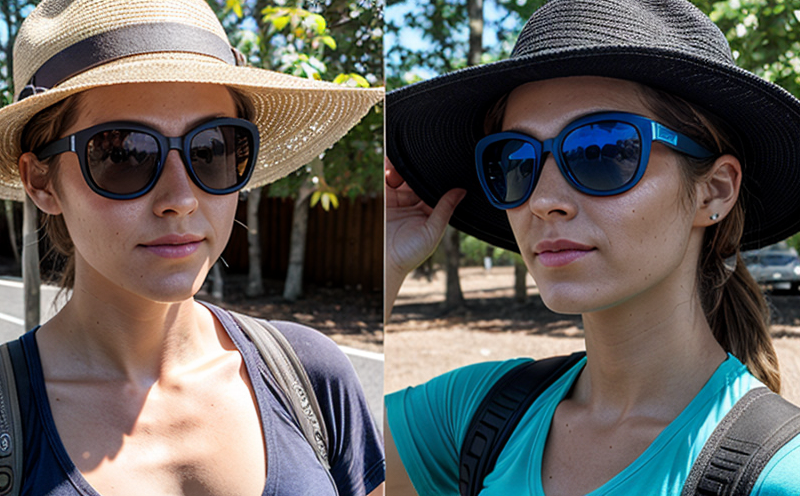UV protection testing of children’s clothing fabrics
The need to ensure that children's clothing is UV protected has become increasingly important as concerns about sun exposure and its potential health effects grow. This service provides detailed analysis of how different types of fabric perform under ultraviolet (UV) light, ensuring safety and compliance with international standards for textiles.
Our testing process involves rigorous evaluation using advanced instrumentation to simulate real-world conditions children face when outdoors. By understanding the breakdown of UV light transmission through various materials, we can help manufacturers identify which fabrics will best protect against harmful UV rays while maintaining comfort and style.
The importance of this service cannot be overstated. According to the World Health Organization (WHO), prolonged exposure to UV radiation can lead to skin cancer and other serious health issues. Therefore, it is crucial that children's clothing offers adequate protection from these risks. Our lab adheres strictly to ISO standards when conducting tests.
During our testing process, we follow a series of steps designed to simulate real-life scenarios accurately. Specimens are exposed to artificial sunlight for varying durations and intensities. We then measure the amount of UV radiation that passes through each sample using specialized equipment.
The results provide valuable insights into fabric performance under different conditions, allowing designers to make informed decisions about material selection. This information is vital not only from a safety perspective but also because parents often seek out clothing with high UV protection ratings when shopping for their children.
In addition to providing quantitative data on UV transmission rates, we offer qualitative assessments of fabric properties that contribute to overall UV protection effectiveness. These include factors such as thickness, weave density, and color pigmentation. Understanding these aspects helps us pinpoint exactly what makes a particular material more or less effective at blocking harmful UV rays.
Our expertise lies in ensuring not only compliance with current regulations but also anticipating future trends in child safety standards related to UV protection. By staying abreast of changes in both regulatory requirements and consumer expectations, we ensure that our clients remain ahead of the curve when it comes to developing safe and effective products.
It is worth noting that while this service focuses primarily on children's clothing fabrics, its principles apply equally well to other types of apparel intended for young people. Whether you're designing swimwear, outdoor gear, or casual wear, understanding how your materials interact with UV light can significantly enhance product safety and appeal.
Why It Matters
- Health Risks Associated With Sunlight: Prolonged exposure to UV radiation is linked to skin cancer, premature aging of the skin, and other health issues.
- Consumer Demand For Protection: Parents increasingly demand clothing that provides high levels of UV protection for their children.
The stakes are high when it comes to protecting our youngest consumers from the harmful effects of sunlight. Given that children have thinner skin and spend more time outside than adults, they are particularly vulnerable to damage caused by UV radiation. Ensuring that clothing items like t-shirts, shorts, and hats offer robust protection is essential.
Moreover, as societal awareness around environmental sustainability grows, so too does the importance of selecting materials that not only meet strict safety standards but also have minimal impact on the planet. This dual responsibility emphasizes why accurate UV testing plays such a critical role in modern textile manufacturing practices.
Quality and Reliability Assurance
- Compliance With International Standards: Our laboratory adheres strictly to ISO standards when conducting UV protection tests on children's clothing fabrics.
- Repeatable Results: Consistent test results across multiple trials, ensuring reliability and accuracy of findings.
Our commitment to quality extends beyond just meeting basic regulatory requirements; we aim to set new benchmarks for excellence in UV protection testing. By consistently delivering repeatable results, we ensure that our clients can trust the data generated by these tests.
One key aspect of our approach is adherence to international standards such as ISO 12727-3:2015. These guidelines provide clear criteria for determining whether a particular fabric provides sufficient UV protection, allowing us to make accurate assessments based on universally accepted benchmarks.
In addition to compliance with these standards, we also place great emphasis on ensuring that our testing methods are repeatable. This means that when different samples of the same material are tested under identical conditions, they should yield similar results each time. Repeatability is crucial for maintaining consistency and building confidence in the accuracy of our findings.
The pursuit of reliability doesn't stop there; we also invest heavily in continuous improvement efforts aimed at refining our testing protocols further still. By staying current with advancements in technology and methodology, we ensure that our laboratory remains at the forefront of UV protection testing capabilities.
Environmental and Sustainability Contributions
- Eco-Friendly Materials: By recommending sustainable alternatives during the testing process, we encourage manufacturers to adopt environmentally responsible practices.
- Minimized Waste: Efficient use of resources throughout the testing procedure reduces overall environmental impact.
The environmental and sustainability contributions of our UV protection testing service go beyond mere compliance with regulations. We actively promote eco-friendly materials that offer superior UV protection without compromising on performance or aesthetics.
One example is recommending fabrics made from organic cotton, which has been shown to require less water and fewer pesticides compared to conventional alternatives. By incorporating such sustainable practices into our testing protocols, we aim to drive positive change within the industry.
We also focus on minimizing waste throughout every stage of the testing process. This includes efficient use of resources like electricity and chemicals used in preparing specimens for analysis. Our efforts contribute significantly towards reducing the carbon footprint associated with textile manufacturing processes.
By advocating for sustainable practices, we hope to inspire a culture of responsibility among manufacturers who understand that protecting both human health and planetary well-being is intertwined. Our goal is not only to provide reliable testing but also to foster innovation in creating products that are both safe and environmentally friendly.





